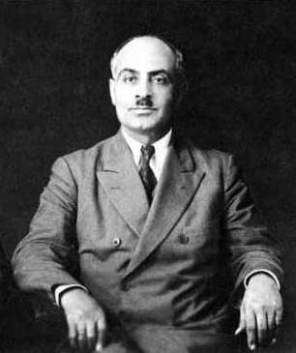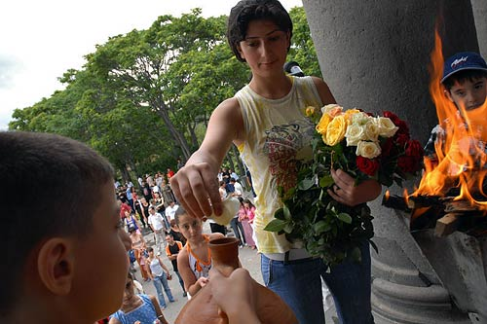Written and copyrighted by Týra Alrune Sahsnotasvriunt, 2014.
Before we explore Armenian Hetanism, or in translation “Heathenry”, a bit further, let me take you on a very brief semi-political excursion.
The revival of Armenian Paganism has been widely criticized due to the political affiliations of its revivers.
Edik “Slak” Kakosyan and Garegin Nzhdeh both are known as “nationalists”. Most of us, especially in the West, have an idea on what nationalism is; we associate it with tyranny, dictatorship,racism, world wars and the death of millions.
Whilst these forms of nationalism are ghastly, fascist, absolutely and without a doubt condemnable, nationalism by definition neither includes these things, nor the glorification of violence in general. I am neither advocating nor condemning nationalism in this article, merely explaining the background of this (and other European) Pagan revival movements.
Often the survivors of a people that were wiped out systematically turn to fervent patriotism or nationalism and thus the nationalist movement in Armenia comes as no surprise.
(References re. the Armenian Holocaust by the Turks: http://en.wikipedia.org/wiki/Armenian_Genocide and also http://www.dailymail.co.uk/news/article-479143/The-forgotten-Holocaust-The-Armenian-massacre-inspired-Hitler.html)
In 1991 Kakosyan had founded “The Order of Ari” (Order of the Aryans or also Order of Ari (the first form of men) or also Children of Man. Please note: Aryan in its original meaning also has nothing to do with nazi ideology and is just another word for indo-European. http://en.wikipedia.org/wiki/Aryan ), following up on Nzhdeh’s ideas, ideals and goals of the Tseghakron, “religion of the nation” as brought to life shortly after the end of the Armenian Holocaust around 1915. Kakosyan, while in exile, had also codified Nzhdeh’s Ukhtagirk, “Book of Vows” in which Nzhdeh was almost deified and compared to the Pagan high God, Vahagn, God of the sun, of war and the Aryan Armenian nation.
Although many were skeptical towards the latter mentioned Hetanism grew steadily, not just Pagans but even devout Christians soon started gathering at the Temple of Garni to celebrate the ancient holy days and festivals and also celebrate their heritage. Some even insist that it helped them overcome the trauma of the genocide they still dealt with.
It has gained enough acceptance for the current president of the Republican Party of Armenia to out himself as a Hetanist. Former Prime Minister Andranik Margaryan is a big supporter of the Hetanist movement to this day.
Despite the fact that it was the conservative, republican and nationalist parties, clubs and organizations that helped Hetanism to its feet, the priests of the Temple of Garni are not allowed to join any political organizations, parties or make their personal political opinion publicly known. Hetanism is for every Armenian is the credo.
Other than by Armenian intellectuals Tseghakron is favored by the rural population which often kept their folk traditions, customs and beliefs as inspired by the Old Pagan Religion. It is due to them that fragments (!) of the old poems and songs survived Christianization until this day, further filling in blanks about the nature of worship and spiritual everyday life. It was easier for them to relate to Storm- and Sungods, a spiritual duality and animism rather than Armenian Orthodox Christianity. They also often believe in the Gods as physical entities while neo-Pagan intellectuals subscribe to the concept of Nzhdeh’s “divinely inspired” Ukhtagirk: monism. – According to this book, first there was Ar (reminding of Norse Ginnungagap or the Christian nothingness that was before God created light) and Ara the “universal architect”, who reminds of Zoroastrian Ahura Mazda or Hindu Brahma was the creator of the Gods, earth and universe and has no form, no qualities nor personality. He was later called Aramazd.
Etymologically Ar is the origin of words such as womb, blood, sun, art.
Just like many other ancient civilizations or belief systems, original Tsegakhron along with almost all sources, texts and artifacts, was destroyed by Christianity. Hence Hetanists rely on the Ukhtagirk for spiritual guidance regarding rituals, celebrations, holidays and conduct.
The historically most reliable source of information – despite single accounts of Hetanism in the works of Plato, Heredotus, Xenophon and Strabo – is the Hayots Patmut’yun, “The History of Armenia” by Movses Khorenatsi, which was written in the 400’s AD. Hetanism is only partly a reconstructionist religion, today’s followers fill in the blanks with elements from sibling-traditions such as Hellenism, Zoroastrianism and Hinduism.
There are three rites of passage in Hetanism, the Knunk, a baptizing/saining ritual for those who convert or rather, revert to their ancestors’ religion. Second is Psak – wedding and then the last rite or death ritual. These are held individually within smaller communities and kindreds or even solitary but also regularly at The Temple of Garni in the Kotayk province (ca. 3rd century BC), the only Pagan, Hellenic styled Temple which survived the Christianization and was dedicated to Zoroastrian/Armenian Sungod Mihr and Greek Zeus before it was rededicated to Vahagn.
Other Hetanist holy days include amgonst others
Terndez on Feb. 14th which is similar to Pagan Valentine’s Day,
Hambardzum (Ascension Day celebrated 40 days after “Easter”),
Vardavar which was connected with The Goddess of beauty – Astghik and her love with Sungod Vahagn. Khaghoghorhnek is a day for the remembrance of the ancestors (Sept. 20th),
Zatik is the Aryan New Year and birthday of the Sungod Vahagn (March 21st) on which winter is separated from spring, in fact Vaha meaning God and Agn meaning Fire (note: In Hinduism Agni is the God of Fire as well) and the Navasard.
As in all other Pagan religions the Sun and Moon were sacred, days were dedicated to each, Hetanists prayed facing the East and were also buried facing East in the hope of “rising in the afterlife”. The Moon was venerated, but also slightly feared as it was associated with (female) mysteries, death and also (evil) spirits and believed to be a “young maiden in the sky” whereas the Sun was actually a young man smiling down upon the land.
As far as we know women were still treated well, often not just equally to men but they were looked at as sacred children of the Moon/Great Mother.
Depending on the specific (sub-)cult or community, the stars were believed to be the children of Sun and Moon or the ancestors and the Zodiac, sun and moon phases were paramount in order to determine one’s destiny. They were the means by which Ara (the great impersonal life force) communicated with the people.
Bronze age pictures, statues and bas-reliefs depict the lion, bull, deer, bear, horse, sheep and ox as well as the stork, eagle, rooster, crane and swallow in a spiritual or “holy” context and indicate that Hetanism was a totemic religion.
The worship of the elements appears to also have been a part of original Hetanism, but it is their fervent worship of the element of Fire which earned them the name of “ash-worshippers” by early Christians that came in contact with this religion. Fire represented not only physical light or illumination but also metaphysical enlightenment. To this day putting out a fire, and if it is only a candle, requires more than just snuffing or blowing out the wick, for many Armenians there is a ritual to be followed in order not to invite unwanted spirits. Even less spiritual Armenians and non-Hetanists at least put out fire or a candle with care and some basic respect.
Some of the ancient Gods, demons and beings are still found in Armenian fairy tales, though they are often not called by their original names out of fear of persecution by the church back then.
I mentioned earlier that Ara(mazd) basically translates to life. Now, it is interesting to note that his wife’s name was Sandaramet and she was the female equivalent of Hades, basically Death embodied.
Aramazd’s “shepard on earth” or attending incorporeal spirit was Tir, meaning “writer”. He walked the earth, recording mankind’s deeds and thoughts, taking his accounts of it back to Aramazd who then judged each individual according to his/her deeds and thoughts after death. Tir represented both hope and fear and whenever someone had cursed loudly or spoken badly about someone whispers would be heard, warning of Tir’s possible presence.
Mihr was Aramazd’s son, the God of Fire to whom many temples were dedicated. Much like Norse Týr was replaced by the foreign Wotan/Odin, Mihr faded into the background after Vahagn became more popular.
Aramazd’s daughter Anahit’s Greek equivalent was Artemis. She was called “the spotless Goddess” or “Golden Mother”, representing purity and chastity. She was Armenia’s protector and benefactress.
Anahit’s sister Astghik married Vahagn. He was also called Vishapakagh, “uprooter of dragons” (snakes), as he roamed the lands in order to free Armenia and its population from evil spirits, demons and monsters.

(Vahagn as Vishapakagh)
Aramazd’s third daughter’s name was Nooné. Especially the rural population could relate to her best since she was the Goddess of contrivance. Odds were often against her but she always somehow emerged from trouble, woes and tight spots triumphantly.
Except Vahagn most of these Deities were rather gentle deities, this is also reflected in the Armenian holy days which often central around love, beauty and fidelity.
Hetanism is a small religion mainly heard of and lived in Armenia itself, although the Armenian Diaspora (especially in the US) is finally starting to catch on and embrace its native Pagan roots. Hopefully it will grow and prosper just as much as the majority of the other indo-European Pagan religions currently are. At least I am hoping for some timely in-depth literature on this fascinating religion!




